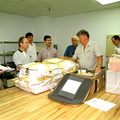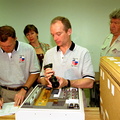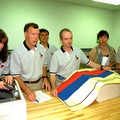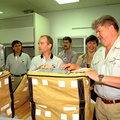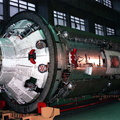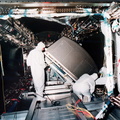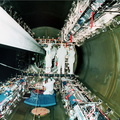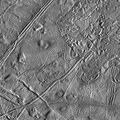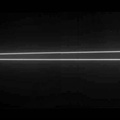
WIKIARCHIVES.SPACE
The Human Spaceflight Archive

The Great Red Spot of Jupiter as seen through a "Methane" filter (727 nm) of the Galileo imaging system. The image is a mosaic of six images that have been map-projected to a uniform grid of latitude and longitude. North is at the top. The mosaic was taken over a 76 second interval beginning at universal time 14 hours, 31 minutes, 52 seconds on June 26, 1996. The Red Spot is 20,000 km long and has been followed by observers on Earth since the telescope was invented 300 years ago. It is a huge storm made visible by variations in the composition of the cloud particles. The Red Spot is not unique, but is simply the largest of a class of long-lived vortices, some of which are visible in the lower part of the image. The range is 1.46 million kilometers.
Information
- Taken in
- Author
- NASA/JPL-Caltech
- Description
-
The Great Red Spot of Jupiter as seen through a "Methane" filter (727 nm) of the Galileo imaging system. The image is a mosaic of six images that have been map-projected to a uniform grid of latitude and longitude. North is at the top. The mosaic was taken over a 76 second interval beginning at universal time 14 hours, 31 minutes, 52 seconds on June 26, 1996. The Red Spot is 20,000 km long and has been followed by observers on Earth since the telescope was invented 300 years ago. It is a huge storm made visible by variations in the composition of the cloud particles. The Red Spot is not unique, but is simply the largest of a class of long-lived vortices, some of which are visible in the lower part of the image. The range is 1.46 million kilometers.
The Jet Propulsion Laboratory, Pasadena, CA manages the mission for NASA's Office of Space Science, Washington, DC.
- Created on
- Thursday 26 March 1998
- Albums
- US SPACE PROGRAM / PROBES / JUPITER / GALILEO / Mission Photos (Edited) / JUPITER
- Source link
- https://photojournal.jpl.nasa.gov
- Visits
- 15
- Rating score
- no rate
- Rate this photo
- License
- Public Domain
- Modified by WikiArchives
- No (original)
- Downloads
- 0
Powered by Piwigo
